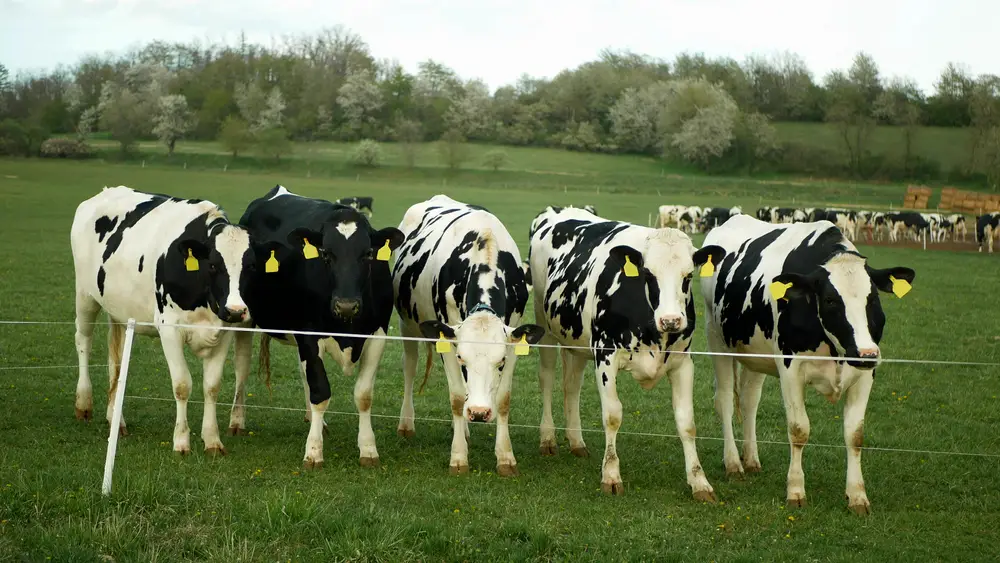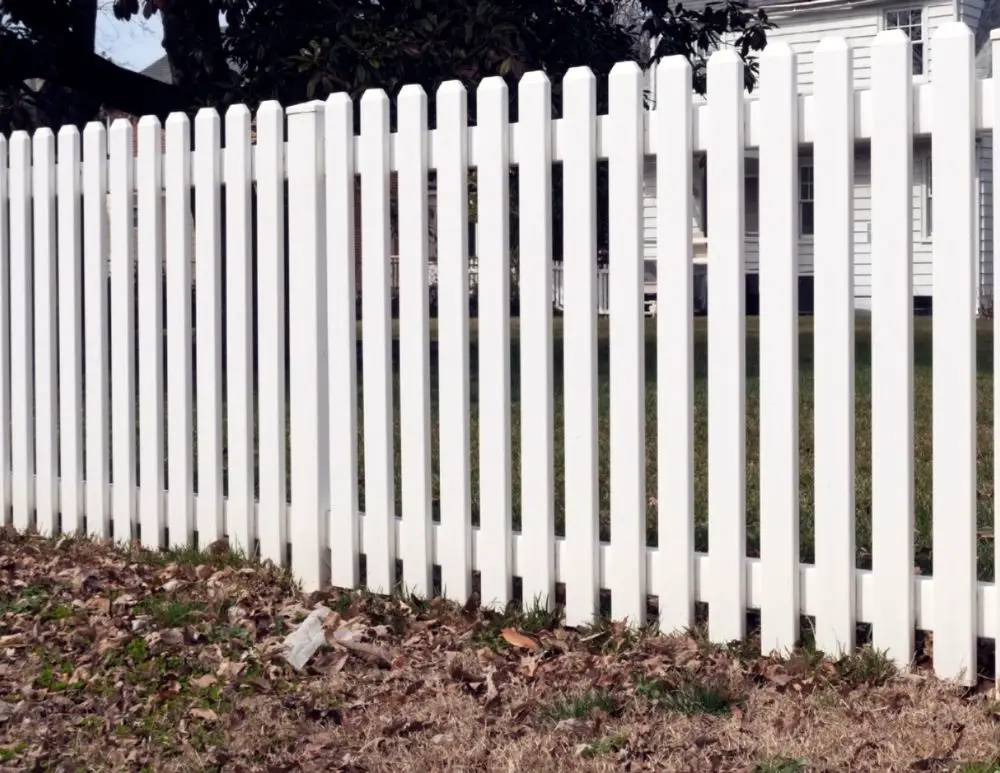The five most familiar types of fencing are hinged joint, fixed knot, electric, barbed wire, and wood post. Synthetic forms of fencing are also present on modern-day farms.
Cattle fences have been around in some shape or form as long as domesticated cattle – over 10,000 years! The first proper fencing came about as farmers started planting crops. Cattle fences kept cattle out of the crop fields and, over time, away from people as population density increased.
Table of Contents
5 Most Popular Types of Cattle Fencing
Fencing options have moved on from a crooked collection of gathered sticks and fallen branches or piles of stones. Barbed wire first came into use as far back as the 1800s leading to the Texan Fence Wars of the 1880s when fences even started appearing across roads! Nineteenth-century Texas also saw the world’s first electric fencing.
1. Hinged-Joint Fencing
Hinged-joint fencing is the most suitable kind for corralling cattle. The layout is straightforward, featuring a basic grid-like pattern with wooden posts. The design is such that animals will not become tangled in the wire, meaning they are effective for land containing more than just cattle – horses and goats can live in the enclosed space too.

The pricing of hinged-joint fences is low but offset by not being as durable as other options. Unless you pay for thicker beams, heavier animals are prone to knocking them out of shape, resulting in constant maintenance.
Persistent interference from wild animals will also result in wear and tear. Hogs, foxes and rabbits can burrow into the earth around the poles and weaken the structure.
2. High-Tensile Fixed-Knot Wire Fencing
High-tensile wire fencing with fixed knots is a more expensive but longer-lasting option. They retain their shape effectively after knocks or when animals lean into them, requiring less maintenance than the hinged-joint variety.

The wire they use does not contain barbs and will not leave your livestock with open wounds that can become infected. They are also more robust and more resilient to damage by wild animals.
You must balance the higher initial outlay against the efficiency and savings you will make with less maintenance and fewer repairs further down the line.
3. Electric Fencing
Electric fencing is an great option if your paddocks are small or rotational grazing is being used. It is not practical for more extensive pastures due to expense and maintenance issues. Tracking down faults along the fence line is tricky and time-consuming, while weather and wild animals can also damage the insulators.

Although an electric fence uses a rudimentary power system, energizers (or fence chargers) will fail at some point, and electric wire or polywire can be expensive to replace if damaged. Minor or temporary fencing enclosures are the best fit for this kind of fence, especially pens containing more aggressive or in-heat bulls.
4. Barbed-Wire Fences
This type of field fencing is highly effective at keeping animals enclosed. There is the risk, of course, of animals picking up nasty cuts which can fester and need attention, but modern barbed-wire fencing does not tend to cause that.

A modern barbed-wire fence only has one strand of barbed wire, and it runs along the top of the fence which is the shoulder height of a typical cow. Its primary function is to keep wild animals and humans out rather than the cows in. A fully barbed wire fence (one with several rows of barbed wire) is becoming less common.
5. Wooden Post Fencing
Wooden-post fencing (with no wires) is suited to horses or other animals that only require a small enclosure. It is expensive and requires a wood preserver application, especially in more rugged climates. Horses can also tend to gnaw at wooden fences and wounds from splinters can be a problem. A compromise is a mixture of wooden and metal wire materials.

They are best for fencing areas close to your homestead that is aesthetically pleasing. The timber will generally degrade and rot over time if left untreated. In practical terms, wooden post fencing is not your best option.
Synthetic Fencing
Synthetic fencing uses synthetic plastic materials, such as PVC, polyethylene, or polypropylene, and you typically get what you pay for. Ultra-violet light and exposure to the elements can damage plastic over time, so be careful to ensure you buy only high-quality materials that resist cracking or crumbling.

More modern plastic fencing contains UV stabilizers such as titanium dioxide, which protects the posts from bright sunlight. Plastic fencing is typically cheaper and more durable alternative when compared to wooden fencing.
What You Will Need When Building a Livestock Fence
Personal Items
- Heavy-duty gloves – these protect hands from sharp wire edges and splinters. Leather will provide durability and ease of movement, but synthetic gloves or thick rubber ones are also machine-washable and less prone to shrinking.
- Safety glasses – essential when using a chain saw or cutting wire.
Smaller Hand Tools
- Shovel or spade and spirit level.
- Fencing pliers – used for pulling out staples and manipulating wire. Choose from 8- or 10-inch and round or square nose.
- Wire gripper – for tensioning single wires, often used with a come-along.
- Tin snips and wire cutters – ensure they have good-quality edges so they can easily slice through high-tensile wires.
- Crimping tool – for splicing fence wires with swage sleeves (or cable ferrules).
- Hammer – a steel handle is more robust but heavier than a wood or fiberglass one. You will need a hammer to insert driving staples and brace pins.
- Measuring wheel or tape – calculating the distance between fence braces and posts is crucial. Tapes are more accurate but limited in reach.
- Saws – hand saws for smaller jobs, chain saws for larger ones. Go for two-stroke or battery-operated rather than corded.
- Drill – again, cordless is always best. Used to drill holes for brace pins and gate hinges.
- Marking string or wire – also known as mason’s string.
- Fence stretcher – used to grip and tighten strands of a woven wire fence.
- Heavy duty chain – for general use.
Heavier Tools
- Fence post driver, also known as a post-knocker or post-hole digger – makes holes by pulling out the dirt and stones. Fiskars carry a particularly good one. Combine one with a tractor and auger attachment to save time.
- Fence tensioner – used to clamp on to the wire and tension the fence to make it taut and steady. They are also known as straining clamps or monkey strainers.
- Come-Along – also called a cable puller or hand-operated winch. A hand lever pulls your fence wire tight and tensions the fence properly.
- Post driver or post pounder – used to drive T-bar posts in the ground, usually with woven wire fencing. It is a heavy, broad steel pipe with a closed flat end and handles on the side to allow you to drive the post into the ground. Prepare the hole using the tamping tool first.
- Tamping tool or digger bar – a bar with a chiseled point on one end and a flat surface on the other. The sharp end breaks hard ground and the flat one “tamps” the soil around the fence post once you have driven it in with the post driver.
Fencing Materials and Fittings
- Plastic step-in fence posts – used to reinforce parts of a fence system or to make gates.
- Wire – most cattle fences use 12½ gauge wire. If you have particularly aggressive or skittish bulls, go with 9-gauge. Field Fence is an excellent choice. Always use high-tensile wire over standard mild steel if possible and over-estimate rather than under-estimate the quantity you think you will need.
- Creosote – the finest timber-treatment product available, able to protect timber for more than 30 years. Its domestic use is now illegal, although it is still commercially available.
- Posts – go for pressure-dipped creosote if available. Redwood tanalized ones are another desirable choice, although galvanized steel posts are also extremely popular.
- Straining posts – use 8-foot-long posts with a diameter of 6 to 7 inches. Around 45 inches should protrude from the ground.
- Turning and corner posts – used for any angle change when building a farm fence system.
- Struts – these fit diagonally into notches in the strainer post at around 18 inches from the ground.
- Tensioning netting – use ratchet clamps and chains to tension the wire to obtain sufficient wire tension. Tension the wire using a monkey strainer chained around the post.
- Staples – choose the barbed variety as they lock into place better than the smooth kind.
Electrical Equipment
- Electric fence tester – to help you pinpoint trouble spots and get your fence working again. A digital voltmeter that reads up to 10,000 volts will serve you well.
- Electric fence energizer or electric fence charger – converts electricity into a high-voltage pulse.
- T-posts – usually high-quality rolled tail steel.
- Electric fence wire – polywire is electricity-conducting twine specially designed for use in electric fences. Make sure you choose the heavy-duty type to avoid having to change it too frequently.
- Electric fence polytape. This tape is strong and especially useful for areas with faster-moving livestock, such as horses.
- Steel wire and clamp for better conductivity.
- Plastic or porcelain insulators – you will need ring, gate handle, or plastic “cap” insulators, plus a round rod and wire
Types of Fences Unsuitable for Cattle
Rabbit-proof fences, chicken fences, and backyard garden fences do not present a suitable physical barrier to prevent cattle from escaping onto neighboring land. Importantly, they will not prevent predators, other wild animals, and trespassers from entering your property.
Ideal Fence Height for Cattle
Your fence must be robust and clearly visible to a 5-foot-tall cow. Larger animals like bulls may need higher fences, but your cattle fence should be at least 49 inches tall with wire spacing of about six inches. Post spacing should be spaced 20 to 70 feet apart, depending on your breed and typical wind speeds.
How To Repel Cattle Without Electric Fences
Use battery-operated motion sensor lights to repel cattle from weak fences. Cattle can spook when confronted with shade or shadow as they are poor at judging objects that differ in light intensity. Cattle also have poor depth perception and can mistake a shadow for a hole in the ground.
Shadows, bright light, and sparkling reflections will distract cattle. When cattle are in dimly-lit areas, they will walk towards brighter ones – something slaughterhouses take advantage of when enticing cattle into killing areas. They are sensitive to sudden, exaggerated movements and noises.
